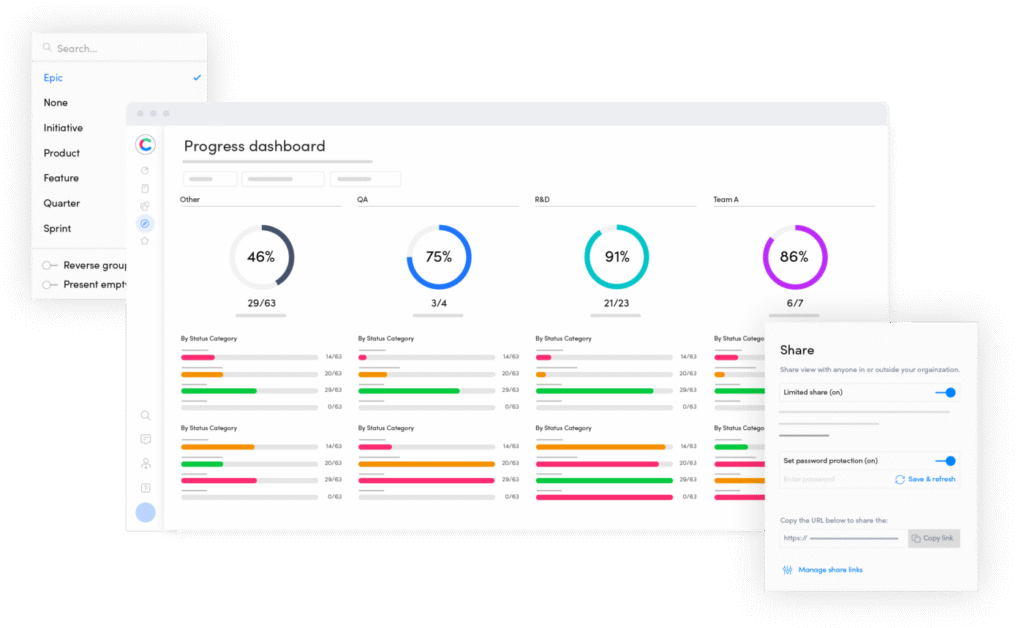Introduction
Choosing the right product management platform can be the difference between a smooth product launch and endless delays. Craft.io is a well‑known player in this space, offering a unified environment where product teams can build roadmaps, prioritize features, and synchronize work with development tools. Designed for mid‑sized to large teams that follow agile methodologies, Craft.io promises clarity and strategic alignment across the entire product life cycle. This review will guide you through the software’s capabilities, pricing structure, user experience, and best use cases so you can decide if it suits your organization.
Software Specification
Craft.io’s Core Features
Craft.io is more than a simple task manager; it’s a strategic product management suite. Below you’ll find a breakdown of its core features and how they support different aspects of product development.
Strategic Roadmap Planning
One of Craft.io’s standout capabilities is its focus on strategic roadmapping. The platform makes roadmaps the centerpiece of its offering. You can visualize high‑level initiatives, align them with company objectives, and communicate your plan to stakeholders. Views are customizable, letting you present the information in timeline, table, or kanban formats. This flexibility helps non‑technical teams stay updated without diving into complex project tools.
Craft.io’s roadmap module connects seamlessly to your backlog, so high‑level goals are tied directly to user stories and tasks. Integrated OKR (Objectives and Key Results) supports linking roadmap items to measurable outcomes, ensuring your team stays focused on the bigger picture.
Backlog Management & Prioritization
An organized backlog keeps product teams efficient. Craft.io provides a structured workspace for managing and prioritizing your backlog. You can import existing items, group them into themes, and apply different prioritization frameworks, such as RICE, MoSCoW, or WSJF, to rank potential features based on effort and impact. Advanced prioritization mechanisms let you plot items on a value‑versus‑effort matrix, helping you make informed trade‑offs.
The backlog management module ties directly into your development tools. If you use Jira or Azure DevOps, Craft.io supports two‑way sync, ensuring tasks stay aligned between planning and execution. It also accommodates a feedback portal (available as an add‑on), allowing user feedback to flow directly into your backlog.
Workflow Customization & Collaboration
Every product team has unique processes. Craft.io’s workflow customization ensures the tool adapts to your methodology rather than forcing a one‑size‑fits‑all approach. You can design your own workflows, define statuses, and create custom fields to suit your data needs. Unlimited views in higher‑tier plans let each stakeholder see information in the format that matters most.
Collaboration is embedded throughout the tool. You can comment on items, @mention colleagues, and share files, keeping discussions centralized. As you work, Craft.io records changes so everyone sees an updated single source of truth. Teams that rely on design files will appreciate the platform’s integrations with popular design tools.
User Story Mapping & Sprint Planning
User story mapping is a technique for understanding user journeys and breaking down features. Craft.io delivers a visual story mapping tool that links user needs to tasks and ensures every feature ties back to user value. You can map epics and stories along a timeline, group them by priority, and see how they contribute to your roadmap.
For Agile teams, sprint planning capabilities are essential. Craft.io provides Scrum and Kanban board views for planning and executing sprints. You can set sprint goals, assign tasks, and track progress through burn‑down charts. The platform helps you avoid overcommitment by factoring in capacity planning (more on that below).
Resource Allocation & Capacity Planning
Knowing your team’s capacity prevents unrealistic timelines. Craft.io’s resource allocation tools let you assess team availability, assign tasks based on capacity, and adjust workloads. For larger teams, the Enterprise plan provides resource planning across multiple product lines, enabling portfolio‑level balancing.
Capacity planning add‑ons (available in Pro and Enterprise plans) simulate how adjusting resources affects capacity without impacting the live roadmap. This forward‑looking view helps product managers plan realistically and avoid burnout.
Analytics & Reporting
Data‑driven decisions require visibility into progress. Craft.io includes analytics dashboards that track KPIs, progress against OKRs, and backlog health. The platform generates reports for stakeholders, with customizable templates to highlight metrics that matter. Automated progress tracking (available in Pro plans) reduces manual updates. These insights help you understand where delays happen and which features deliver the most value.

Pros and Cons
Advantages and Disadvantages
Positive
✅ Intuitive interface
✅ Robust integrations
✅ Advanced features
✅ Strategic focus
Negative
❌ Steep learning curve
❌ Limited out‑of‑the‑box templates
❌ English‑only support
❌ High cost for advanced features
No product is perfect; understanding its strengths and weaknesses helps determine fit. Here’s a balanced view of Craft.io’s main advantages and disadvantages.
✅ Pros
- Intuitive interface: The clean design makes complex product management tasks easier for new and experienced users alike.
- Robust integrations: Craft.io natively connects with essential tools like Jira and Salesforce, plus offers an open API for custom integrations.
- Advanced features: The platform offers sophisticated prioritization, roadmapping, and story mapping that go beyond basic project management software.
- Strategic focus: By embedding OKR frameworks and prioritization matrices, the tool ensures every task ties back to high‑level goals.
❌ Cons
- Steep learning curve: The breadth of features can overwhelm new users, requiring a thoughtful onboarding process.
- Limited out‑of‑the‑box templates: Compared to competitors, Craft.io offers fewer prebuilt templates, which can slow initial setup.
- English‑only support: The interface currently caters primarily to English speakers, limiting adoption for teams that require multilingual support.
- High cost for advanced features: Premium capabilities like capacity planning and OKRs come as add‑ons or higher‑tier plans.

User Experience
How It Feels Like For The User
Craft.io offers a modern, intuitive interface designed to help product teams move from high-level strategy to execution without friction. The layout is clean, the navigation is structured, and the dashboards are easy to interpret, even for non-technical users.
When you first log in, you’ll find three core navigation areas: Strategy, Backlog, and Reporting. This logical separation makes it simple to switch between planning and tracking, ensuring you always know where to find your product data. The sidebar offers quick access to roadmaps, sprints, and insights, while the top bar provides shortcuts for collaboration tools like comments, mentions, and activity logs.
Smooth Onboarding and Learning Curve
Getting started with Craft.io is straightforward thanks to its guided onboarding tours, sample data, and step-by-step setup wizards. New users can learn the basics of roadmap creation, backlog prioritization, and sprint planning in minutes. The platform’s built-in templates and tooltips reduce confusion, which is especially helpful for teams transitioning from spreadsheets or general project management software.
Still, Craft.io isn’t a “plug-and-play” tool. Its advanced capabilities require configuration, so users benefit most when they spend time customizing workflows, fields, and dashboards. Once set up, the workspace feels personalized and efficient.
Clean Design and Navigation
The Craft.io dashboard is visually balanced, offering white space and color coding that draw attention to important metrics and task statuses. You can toggle between Kanban, list, and timeline views, adapting the display to your workflow.
Interactive elements like drag-and-drop cards, filters, and collapsible panels make navigation fluid. The platform’s responsiveness ensures a smooth experience across desktops and tablets, though dense views, like detailed roadmaps, are best explored on larger screens.
Collaboration and Team Visibility
Craft.io’s collaboration tools elevate team alignment. You can @mention teammates, attach files, and comment directly within tasks to keep discussions organized. The activity feed and version history help track changes, reducing confusion about updates or decisions.
Stakeholders without editing rights can still contribute as “viewers” through shared dashboards, making it easy to distribute progress reports and product updates without extra licenses.
Performance and Accessibility
Performance-wise, Craft.io runs smoothly on most browsers. Loading times for large boards are reasonable, and autosave prevents data loss during edits. The design is mobile-responsive, though the compact layout is better suited to tablets than smartphones for intensive work.
For accessibility, text contrast and font choices meet modern standards, but the absence of multi-language support limits global adoption.

Pricing
How Much Does Craft.io Cost?
Craft.io uses a tiered pricing model that scales with team size and feature requirements. All paid plans include a 14‑day free trial, and there are discounts for annual billing.
-
Starter Plan ($24/month or $19/month billed annually): Ideal for small teams starting with product management. It includes one workspace, up to three workspaces and personal views, limited custom fields, and basic features like roadmap creation, backlog management, workflow management, and two‑way sync with a development tool. Unlimited contributors can view and comment without incurring additional cost.
-
Pro Plan ($99/month or $79/month billed annually): Suitable for growing teams needing advanced customization. It includes unlimited workspaces, unlimited integrations, unlimited custom fields, unlimited prioritization frameworks, design tool integrations, LiveShare, and automated progress tracking. Add‑ons for OKRs, feedback portals, and capacity planning cost $20 per user (monthly) or $15 per user (annually).
-
Enterprise Plan (custom pricing): Designed for large organizations with complex workflows. It includes everything in Pro plus on‑premise Jira and Azure DevOps integrations, portfolio roadmaps, product portfolio management, multi‑level OKRs, cross‑product dependencies, automation rules, and enterprise‑grade security features like SSO, audit logs, IP whitelisting, and dedicated customer success support. All add‑ons are included.
From a value perspective, the Starter plan is affordable for small teams but limits customization and views. Pro users gain significant flexibility, though the add‑on costs can increase expenses. Enterprise customers benefit from bespoke onboarding and advanced features that justify a higher price.
| Feature Type | Starter | Pro | Enterprise |
| Best For | Small product teams starting with structured planning | Growing teams needing full customization and automation | Large organizations managing complex portfolios |
| Monthly Pricing | $24/user (or $19 billed annually) | $99/user (or $79 billed annually) | Custom pricing |
| Workspaces | 1 workspace | Unlimited | Unlimited |
| Views & Custom Fields | 3 workspace & personal views, limited fields | Unlimited views & custom fields | Unlimited + advanced hierarchy |
| Prioritization Frameworks | Basic (RICE or MoSCoW) | Unlimited frameworks + Value/Effort Matrix | Advanced + multi-product prioritization |
| Roadmaps & Dashboards | Basic roadmap builder | Customizable, interactive dashboards | Portfolio-level and multi-product roadmaps |
| Integrations | 1 development tool (Jira, Azure, or GitHub) | Unlimited integrations + design tools | On-prem Jira & Azure DevOps + Salesforce |
| Add-Ons | – | OKRs, Feedback Portal, Capacity Planning ($15–$20/user) | All add-ons included |
| Automation & Progress Tracking | Manual updates | Automated progress tracking | Custom automation rules |
| Security & Admin Controls | Basic permissions | Role-based access | SSO, SAML, IP whitelisting, audit logs |
| Support | Email & Knowledge Base | Email + onboarding assistance | Dedicated Customer Success Manager |
| Trial | 14-day free trial available on all plans | ||
Compare with Others
Alternatives to Craft.io
monday dev – Best for Agile Teams Who Want Visual Control
monday dev, built on monday.com’s Work OS, is ideal for product and engineering teams that value visibility and collaboration. It emphasizes flexible boards, real-time dashboards, and integrated automation, allowing teams to track sprints, bugs, and features in one unified space.
Compared to Craft.io, monday dev focuses more on team-level execution than long-term product strategy. It’s perfect for startups and growing teams that want agility and simplicity over complex portfolio management.
Why choose monday dev:
- Highly visual and beginner-friendly interface
- Strong automation and integration ecosystem
- Ideal for cross-functional teams working in Agile environments
💡 Takeaway: If your focus is execution speed and visual workflows, monday dev provides a smoother onboarding experience and better scalability for multi-department collaboration.
ClickUp – Best for All-in-One Work and Product Management
ClickUp offers unmatched flexibility for teams seeking to manage everything, from product planning to documentation, in one place. You can customize ClickUp to function like Craft.io using Goals, Docs, Whiteboards, and Custom Fields, but it’s not purpose-built for strategic product management.
While Craft.io excels in structured roadmaps and prioritization, ClickUp delivers a broader toolkit for task management, sprint tracking, and communication.
Why choose ClickUp:
- Combines product, project, and team management in one tool
- Robust free plan and flexible pricing tiers
- Highly customizable workflows for both Agile and hybrid teams
💡 Takeaway: ClickUp is a great alternative if you want a flexible workspace that scales beyond product management, though Craft.io is better for teams focused on product strategy.
Backlog by Nulab – Best for Small Development Teams
Backlog, by Nulab, is an affordable project management tool that combines task tracking, version control, and bug management. It’s best for smaller teams that want a lightweight alternative to complex tools.
While Craft.io targets strategic product managers, Backlog is more suited to developers and startups managing code and simple projects in one space. It’s intuitive but lacks the advanced strategic planning and prioritization features that Craft.io offers.
Why choose Backlog:
- Clean interface tailored for developers
- Built-in Git and SVN repositories
- Lower cost of entry for small teams
💡 Takeaway: If your main focus is managing development tasks efficiently, Backlog is a practical, cost-effective choice. For larger teams needing strategic alignment and portfolio views, Craft.io remains stronger.
Aha! – Best for Strategic Product Roadmapping
Aha! is one of Craft.io’s closest competitors in the product strategy and roadmapping space. It offers an impressive suite for goal setting, idea management, and release planning.
Both tools cater to experienced product managers, but Aha! leans more into top-down strategy, while Craft.io blends strategy with agile execution and integrates seamlessly with Jira or Azure DevOps. Craft.io’s prioritization frameworks and capacity planning tools make it slightly more adaptable for dynamic teams.
Why choose Aha!:
- Excellent visualization for long-term roadmaps
- Built-in idea management and feedback features
- Advanced reporting and capacity planning
💡 Takeaway: Aha! is ideal for executive-level planning, while Craft.io delivers tactical control for cross-functional product teams.
| Feature Type | Craft.io | monday dev | ClickUp | Backlog |
| Primary Focus | Strategic product management | Agile project execution | All-in-one work management | Lightweight dev collaboration |
| Best For | Mid-large product teams | Agile startups | Cross-functional teams | Small dev teams |
| Integrations | Jira, Azure, Salesforce | GitHub, Slack, Zoom | 1,000+ via Zapier | Git, SVN, Slack |
| Learning Curve | Moderate | Low | Moderate | Low |
| Pricing Model | Starts $24/user/month | Starts $10/seat/month | Free–$29/user/month | Free–$35/month |
Use Cases and Best Practices
How to get the most out of craft.io
Craft.io shines in environments where product strategy, roadmapping, and collaboration are paramount. Mid‑sized and large tech companies that follow Agile methodologies will benefit from its advanced roadmapping, prioritization, and capacity planning tools. Teams with multiple stakeholders across departments, product, engineering, marketing, and sales, can use Craft.io to keep everyone aligned on product goals.
The platform may not be ideal for very small startups or solo entrepreneurs. The learning curve and cost structure could outweigh the benefits for teams that need a simple task manager. Organizations with limited budgets or those who prefer more basic tools may find alternatives like Trello or Asana more suitable.
For non‑tech industries or teams unfamiliar with Agile terminology, the richness of features could be intimidating. If your primary need is straightforward project tracking, consider simpler, less specialized software.
Security and Compliance
What about security?
Customer Support and Onboarding
How is Craft.io support
Craft.io provides a knowledge base, documentation, and tutorials that cover everything from initial setup to advanced features. Support is offered via email, and Pro and Enterprise clients can expect personalized onboarding sessions. However, the platform does not offer 24/7 live chat support, which means responses may take longer outside of business hours. For teams in time zones far from the support center, delays could be frustrating.
Enterprise customers receive a dedicated customer success manager and bespoke training sessions. This level of support ensures that larger organizations can roll out the software effectively and adopt best practices. Starter users should rely on self‑service resources and community forums to get up to speed.
Conclusion
Final Thoughts
If your team is ready to elevate how it plans, prioritizes, and executes product strategy, Craft.io is one of the most capable product management platforms on the market. It bridges the gap between high-level vision and day-to-day execution, something few tools manage to do well.
Craft.io excels in helping you connect product goals to actionable plans through its advanced roadmapping, prioritization frameworks, and capacity planning tools. The ability to integrate seamlessly with systems like Jira, Azure DevOps, and Salesforce means you can keep your engineering and business teams aligned within a single ecosystem.
Its intuitive UI, flexible workflows, and data-driven insights make it a strong choice for mid-sized to enterprise-level organizations that value both structure and agility. Whether you’re defining OKRs, visualizing dependencies, or aligning roadmaps with corporate strategy, Craft.io provides a clear and controlled environment for every stage of product development.
However, smaller teams or early-stage startups might find Craft.io’s extensive feature set more than they need. The learning curve and add-on pricing can add up, so if your goal is fast setup and simplicity, platforms like monday dev or ClickUp may fit better.
For established teams managing multiple product lines or seeking a unified, strategic workspace, Craft.io delivers outstanding depth, configurability, and enterprise reliability.
Have more questions?
Frequently Asked Questions
1. What is Craft.io used for?
Craft.io is a product management platform that helps teams plan strategic roadmaps, manage backlogs, prioritize features, and collaborate with stakeholders. It is designed for mid‑sized to large teams following Agile methodologies.
2. Does Craft.io integrate with other tools?
Yes. Craft.io integrates with Jira, Azure DevOps, Salesforce, GitHub, and other development platforms. It also offers an open API for custom integrations.
3. Is Craft.io suitable for small startups?
Smaller teams may find Craft.io’s feature set and pricing overwhelming. The Starter plan is affordable but limited; simpler tools like Trello or Asana may better serve early‑stage companies.
4. How much does Craft.io cost?
The Starter plan is $24 per user (monthly) or $19 per user (annually). The Pro plan costs $99 per user (monthly) or $79 per user (annually), with add‑ons for OKRs, feedback portals, and capacity planning. Enterprise pricing is custom and includes all features.
5. Does Craft.io offer a free trial?
Yes. All paid plans come with a 14‑day free trial, allowing you to test the platform before committing to.
6. What prioritization methods does Craft.io support?
Craft.io supports frameworks such as RICE, MoSCoW, WSJF, and custom prioritization matrices. These tools help teams evaluate and rank features based on value and effort.
7. Can I customize workflows and fields?
Absolutely. Workflow customization is one of Craft.io’s strengths. You can tailor statuses, create unlimited custom fields (in Pro and Enterprise plans), and design views that reflect your process.
8. Is there an option to manage multiple products or portfolios?
The Enterprise plan includes product portfolio management and multi‑product roadmaps. This feature is ideal for organizations overseeing several product lines.
9. How secure is Craft.io?
Craft.io’s Enterprise plan includes security features like Single Sign‑On (SSO), SAML, IP whitelisting, audit logs, and enterprise privacy controls. These features help protect sensitive data and meet compliance requirements.
10. What kind of support does Craft.io provide?
Users have access to a knowledge base and email support. Pro and Enterprise customers receive personalized onboarding and a dedicated customer success manager. However, live chat and 24/7 phone support are not currently offered.







